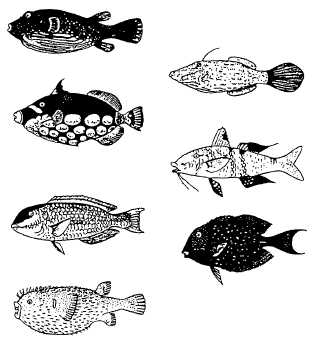Most fish poisonings occur from eating fish that
normally are considered to be safe to eat. However,
fish can become poisonous at different times of the
year because of their consumption of poisonous algae
and plankton (red tide) that occur in certain locations.
The signs and symptoms of red tide paralytic shellfish
poisoning are tingling and numbness of the face and
mouth, muscular weakness, nausea and vomiting,
increased salivation, difficulty in swallowing, and
respiratory failure. Primary treatment is directed at
evacuating the stomach contents as soon as possible. If
the patient has not vomited, select the appropriate
method to remove the stomach contents by either syrup
of Ipecac or gastric lavage. If respiratory failure
develops, support ventilation and other life-sustaining
systems as needed.
Examples of fish that are known to be poisonous
AT ALL TIMES are shown in figure 5-1.
The symptoms of shellfish and fish poisoning are
tingling and numbness of the face and mouth, muscular
weakness, nausea and vomiting, increased salivation,
difficulty in swallowing, and respiratory failure.
Primary treatment is directed toward evacuating
the stomach contents. If the victim has not vomited,
cause him to do so. Use syrup of Ipecac, gastric lavage,
or manual stimulation; then administer a cathartic. If
respiratory failure develops, give artificial ventilation
and treat for shock.
INHALATION POISONS
In the Navy, and in other industrial settings in
general, inhalation is the most common route of
exposure to toxic substances. The irritants and
corrosives mentioned in tables 5-2 and 5-3 are more
often a source of poisoning by means of inhalation
rather than by ingestion. An inhaled poison can act
directly on the upper respiratory tract or lungs with
immediate, delayed, or chronic effects, or the
substance can use the pulmonary system to gain entry
into the body, be absorbed into the blood, and cause
toxic effects (systemic toxicity) at a distant site of
action.
The handling of large quantities of petroleum
products (fuel oil and gasoline, in particular)
constitutes a special hazard, since all of these products
give off hazardous vapors. Other poisonous gases are
by-products of certain operations or processes:
exhaust fumes from internal combustion engines;
fumes or vapors from materials used in casting,
molding, welding, or plating; gases associated with
bacterial decomposition in closed spaces; and gases
that accumulate in voids, double bottoms, empty fuel
5-7
Toxin
Source
C i g u a t o x i n
( c h o l i n e r g i c
effects)
tends to be found in fish from coral
reefs, including barracuda, grouper,
red snapper, parrot fish
Scombrotoxin
(histamine-like
reaction)
tuna, bonito, skipjack, mackeral,
mahi mahi
Saxitoxin
( n e u r o l o g i c
effects)
bivalve shellfish (mussels, clams,
scallops) accumulate toxin from
dinoflagellate during red tides
causing A paralytic shellfish
poisoning@
*Tetrodotoxin
(neurotoxin)
*Neurotoxin
bacteria found in puffer fish,
California newt, eastern salamander
Moray eel
* toxic at all times
Table 5-4.—Examples of Toxins from Fish Known to be
Poisonous
PUFFER
TRIGGERFISH
PARROT FISH
PORCUPINE FISH
FILEFISH
SURMULLET OR GOATFISH
SURGEONFISH
HM3f0501
Figure 5-1.—Poisonous fish.

